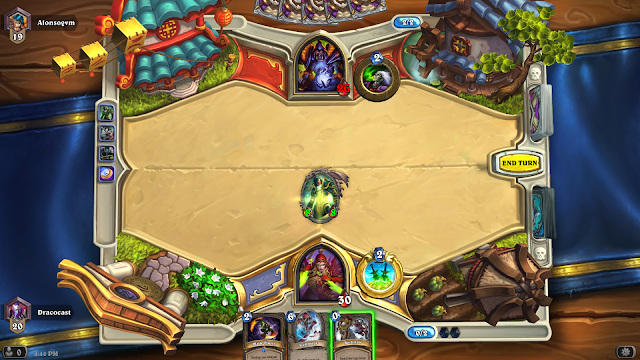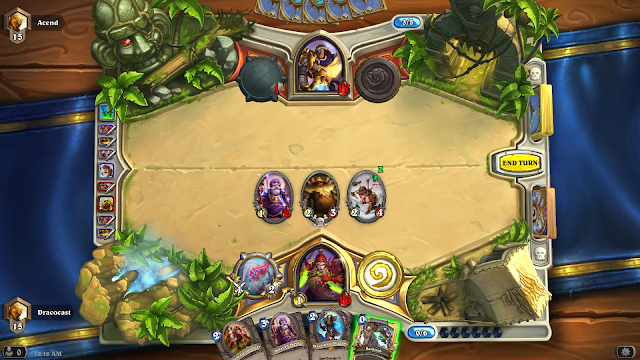Become an Efficient Player

Aside from
Lack of patience, inefficiency is one the biggest mistakes I see Hearthstone players make. Some examples of inefficient play include trading down, wasting spells, failing to use combos, misusing the weapon and using Hero health as the sole metric for determining which player is winning a match.
Although the number of inefficient plays per match is definitely greater for beginners, even the very best players are guilty of making inefficient plays. I admit that I too am a constant offender of making poor plays (more often than I would like).
However, while every player is bound to make inefficient plays, the key is to learn how to limit those inefficiencies and increase the number of efficient plays. In order to do this, one must first learn what those inefficient plays actually are and how to turn them into efficient plays. The following is a list of common plays that beginners often make.
Trading Up vs. Trading Down

Trading up is essentially using a weaker card to kill a stronger card, while trading down is just the opposite. Your goal should always be to trade up. This will allow you to consistently build the momentum in your favor. A simple example of trading up would be using a 3/1 Minion to destroy an opponent's 4/3 Minion.
Spell cards can also be used to trade up, especially for Rogues who rely heavily on spell damage. A simple example of trading up as a Rogue would be using
Backstab on a 3/2 minion. Often time you can use
Backstab to kill a 3/2 and then combo the
Eviscerate to destroy a 5/4 or 4/4 Minion.
This would be a very efficient play as
Backstab costs zero Mana and
Eviscerate only costs two. Plays such as these will give you a strong advantage against your opponent.
While trading up is great, often times trading a single card for multiple cards is even better!
Trading One Card for Multiple Cards
If you can take out two cards, three cards or even more with a single card you are almost always guaranteed to come out on top after the exchange. While each Class has ways of destroying multiple minions with a single card, my Rogue favorites are Blade Flurry & Fan of Knives. Whether it be destroying with five or six Minions at once or
dealing with mech it is a great feeling to trade a single card for three plus.

Being that my Rogue deck is focused around +Spell Damage, these Rogue AOE spells quickly become extremely efficient. I have often dealt four damage to all enemy Minions in one turn just by using Fan of Knives with three +1 Spell Damage Minions on the board. Plus I get to draw an extra card. Trading one card for many can quickly shift the momentum in your favor.
The following is a list of cards that have the ability to take out many minions at once:
Cards that can Deal Damage to ALL minions: Whirlwind, Death's Bite, Explosive Sheep, Unstable Ghoul, Revenge, Wild Pyromancer, Lightbomb
Cards that can Deal Damage to all enemy minions: Blizzard, Lightning Storm, Shadowflame, Flamestrike, Arcane Explosion, Fan of Knives, Blizzard, Starfall
Cards that can Damage all enemies: Consecration, Blade Flurry, Holy Nova, Explosive Trap, Swip
e
Try out these AOE cards and see what works best for your particular deck. In addition to trading up and defeating multiple minions with a single card, avoiding waste is another crucial part in playing an efficient match.
Avoiding Waste (Minions)
Avoiding waste during a match is very similar to avoiding plays where you are trading down. When it comes to playing Minions, you do not want to play each and every Minion just because you have the Mana to do so. Let's say you have six cards in your hand (four minions) and your opponent has six cards as well. You are on turn #10, and you have enough Mana to play all four Minions. Do you play all four at once?
While this answer is really dependent on many different variables (type of deck you are facing/using, your Class vs. opposing Class, Hero HP/opposing Hero's HP, cards your opponent has already played, etc.). In most cases the answer would be
NO. Why you ask?
It's simple, if your opponent still has six cards it is very likely a powerful AOE spell is coming your way. From my experience, powerful AOE spells are saved for situations just like this. One Flamestrike, Blade Flurry, Consecration, Circle of "Healing", etc. and you are done. Maybe play two Minions instead and see what your opponent counters with. This is a much safer play than wasting all of your Minions on one turn and getting no value from them.
Another wasteful Minion play I see on occasion occurs when one player continuously tries running down a high Health minion (eg. a 2/7) by attacking with three to four low cost minions over the course of one to two turns just to clear the board. There are times when it would be better to leave the enemy 2/7 alone (as it is not a true threat) and just attack the Hero directly. Once you start burning down his Hero, the 2/7 has no choice, but to start attacking your Minions and of course he will then take damage in the process.
Avoiding Waste (Spells)
In my earlier days playing as the Rogue Class I had wasted and had seen others waste countless spell cards attacking the opposing Hero. Unless your deck is 100% geared toward destroying the Hero as quickly as possible or if you are in the process of finishing off the Hero, you should never waste spells this way.
The reason for this is because while you deal maybe 15 to 20 damage to your opponents HP within the first few turns, you are then left with only a few cards. As the match goes on, your opponent is easily able to gain momentum by gaining board control. This means that any minions that you summon will be destroyed immediately.
In addition, your opponent may also be likely to heal themselves during these mid-turns. Being that you no longer have many spells, you are then left with little to no way of dealing additional damage to finish the opponent's Hero.
Instead, spells should be used to efficiently remove enemy Minions from the board. As you improve your Rogue play, you will be able to actually clear an enemy Minion and simultaneously summon a Minion of your own.
As you use Minions & Spells more efficiently you will have more cards toward the end of the game to instantly finish off your opponent. Saving your cards and avoiding waste when playing as the Rogue is surprisingly also largely based on how efficiently you are able to use your hero Power and Deadly Poison Spells.
Deadly Poison/Wicked Knife Do's & Don't's
- Do apply Deadly Poison while you have 2 durability on your Wicked Knife
- Don't destroy your weapon while you have 2 durability on your Wicked Knife (Eg. Blade Flurry)
- Do use Wicked Knife to destroy 1/1 and 1/2 Minions (Also helpful to remove Divine Shield)
- Do not use 3/2 Wicked Knife on 1/1 or 1/2 Minions as it is a waste.
- Do use Wicked Knife against opposing Minions (Use your judgement)
- Do not use Wicked Knife to damage an enemy Hero (Unless used in a match finishing combo)
 Card Advantage vs. Hero Life
Card Advantage vs. Hero Life
When measuring efficiency of play to see which player is winning a match do not use Hero Life total as a sole metric as it can be misleading. Instead the following are more accurate measures of who has the upper hand in a match.
#1. Who has overall Board Control?
#2. Who has the Card Advantage (Most cards in hand)?
#3. Who controls the most powerful Minions on the board?
#4. What type of cards are at each players disposal (Who has the advantage)?
After the top four important questions are answered and it seems like an even match you may then turn to each Hero's Life Total to estimate who is winning the match.
Hope this information helped out some of you newer players. If you have any ideas or helpful tips related to efficient play please share your thoughts in the comments below!
 To answer my question, in August, the Rogue is the Least Played Class in Hearthstone! Out of the 100 games I played, only seven of those games were against Rogues. Out of those seven games. five were Mech decks. Out of those seven games I won six, which equates to an 86% win rate against the Class.
To answer my question, in August, the Rogue is the Least Played Class in Hearthstone! Out of the 100 games I played, only seven of those games were against Rogues. Out of those seven games. five were Mech decks. Out of those seven games I won six, which equates to an 86% win rate against the Class.
 To answer my question, in August, the Rogue is the Least Played Class in Hearthstone! Out of the 100 games I played, only seven of those games were against Rogues. Out of those seven games. five were Mech decks. Out of those seven games I won six, which equates to an 86% win rate against the Class.
To answer my question, in August, the Rogue is the Least Played Class in Hearthstone! Out of the 100 games I played, only seven of those games were against Rogues. Out of those seven games. five were Mech decks. Out of those seven games I won six, which equates to an 86% win rate against the Class. 


































